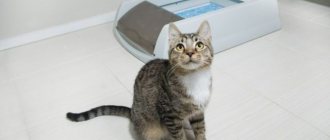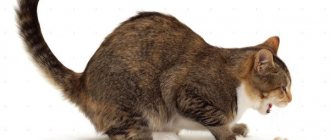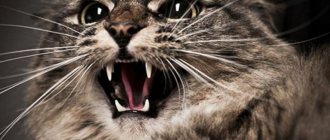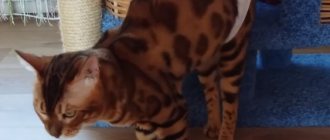12577Administration
If the cat is breathing heavily and wheezing, then this indicates a serious illness. It is necessary to pay attention to the characteristics of the symptoms. For example, when a cat breathes normally, the animal's chest rises and falls. In this case, the process occurs calmly, without jerks or convulsive movements.
However, if the cat begins to breathe from the stomach and sides, this means a disruption in the functioning of the respiratory tract. It is painful for the animal to exhale and inhale, as it does in a normal state. An even more alarming syndrome is when wheezing is added to the symptoms listed above.
© shutterstock
Why this can happen: natural predisposition
If you are the owner of an “English” or a Persian cat, then you will most likely have to come to terms with his “oddities”. The fact is that animals of these breeds belong to the so-called brachycephalic varieties. This is the “scientific” name for mammals that have a shortened head with a characteristic “flat” muzzle.
In the process of breeding such animals, breeders encountered a lot of difficulties. So, the same Persians have a lot of genetic anomalies, many of which are tied to the genome, which provides these animals with a shortened full face of the skull. Whatever one may say, from a natural point of view such a structure is nonsense. In particular, all cats of these varieties are extremely unstable to the effects of very high and low temperatures: the air simply does not have time to warm up or, on the contrary, cool down in their nasal cavity.
In winter, Persians, Britons and cats similar to them constantly catch colds (they should not be allowed outside at all when the ambient temperature drops below 10° Celsius). In the summer, it’s hard and difficult for them to breathe in the heat - hence the “grunting”. Because of this, your pet regularly sneezes when he gets into a dusty room: his respiratory organs simply do not have time to filter everything. But there may be more to it than that.
The problem also lies in the structure of the soft tissues of their palate. Over time, especially in old pets, it can simply “sag,” thereby blocking the normal flow of air. Because of this, the animal becomes even more like a pig. In principle, there is no particular problem here, but... if the grunting becomes incessant, and your cat cannot sleep normally due to “heroic” snoring, we strongly advise you to take him to the veterinarian. It is quite possible that he will need surgery to correct the structure of the soft palate. During the intervention, the surgeon will cut off the “extra” parts that interfere with the normal passage of air. Another sign that “clearly hints” at the need for such a procedure is vomiting, which occurs with particularly strong “grunting”. But there are other causes of grunting breathing, many of which are not so “harmless”.
Causes of wheezing with heavy breathing
This is noisy bubbling breathing. It can occasionally be caused by a cold, and also accompanies most diseases of the respiratory system. A cat often wheezes for the following reasons :
- foaming of accumulated liquid (blood, trans- or exudate);
- the gaps in the respiratory tract narrow.
When the animal loses its voice, it wheezes for a long time. This indicates a violation of the vocal cords, their incomplete closure. The animal will wheeze until they are fully recovered. This phenomenon occurs when mucous fluid accumulates in crevices or with laryngitis.
Changes in a cat's breathing may be a consequence of obesity. In this case, even after little physical activity the animal breathes heavily. Sudden wheezing may indicate that the cat has swallowed a foreign body that is stuck in the throat. You can't try to pull it out on your own. Why can't pet owners do this? Without qualified help, the object can be pushed even further and the animal will die.
"Parasitic" problems
It is known that finding a cat that has not had helminths in its life is a task that is almost impossible in practice. It is extremely easy to “pick up” a parasite for a cat - he does not wash his paws with soap. On the contrary, our clean pets constantly lick their fur, to which anything can stick. For example, parasite eggs. Professional veterinarians generally recommend treating their pets with antiparasitic agents at least once a quarter, since otherwise problems cannot be avoided. Moreover, this must be done at intervals of two weeks...
What to do if your cat has lost his voice
In a situation where a cat has lost its voice, what to do is the first question that puzzles the animal owner. First of all, you need to closely monitor your pet. It is possible that loss of voice is not the only symptom. You should not put off a visit to a veterinarian.
If there is no complete loss of voice, but the cat is hoarse, a veterinarian will also tell you what to do in this situation after examining the animal and finding out the causes of hoarseness. If the cause of the symptom is unfavorable environmental factors (smoky room, foreign odors, use of paints and varnishes, etc.), the animal should be taken out into the fresh air and given milk to drink. After providing first aid, your pet should be shown to a veterinarian to rule out more dangerous causes of muteness.
There are many factors and reasons why a cat’s voice has changed. The owner of the animal should closely monitor changes in the behavior of the pet and, if hoarseness or complete absence of voice is detected, take measures to determine the causes of this symptom. You should not self-medicate a domestic cat or kitten, since the animal should be assisted by a qualified specialist.
Inflammation of the trachea
It is also “tracheitis”. It occurs due to many reasons, with the leading one being the effect of too low temperatures. Your cat, just like a person, can get very cold in frosty or chilly weather. Hypothermia contributes to the deterioration of the animal’s body’s defenses, as a result of which the rapid growth and development of pathogenic and conditionally pathogenic microflora begins. The logical result is that the animal breathes poorly through its nose, making grunting, wheezing and wheezing sounds. But the main symptom of tracheitis is cough.
Foreign bodies
Just like a person, a cat may well choke while eating. Sometimes a couple of minutes are enough for him to cough properly, but sometimes an unsuccessfully swallowed piece of food can end up in the lumen of the respiratory tract. This is fraught not only with the development of “grunting” breathing, but also with something more serious, including the possibility of death from suffocation.
If your cat suddenly starts grunting, wheezing and coughing immediately after eating, call the vet immediately! Even in mild cases, when a foreign body only partially blocks the lumen, all visible mucous membranes of the pet quickly turn blue and become engorged with blood . The result is death from suffocation or severe pulmonary edema . Of course, you can try to remove the foreign body yourself, but in cases where you do not have the appropriate veterinary or medical experience, you should not do this. You will only aggravate the pathological process and possibly injure the animal.
Unfortunately, pieces of unsuccessfully swallowed food are not the worst thing. A similar clinical picture can be caused by tumors, not only benign, but also malignant . Grunting in such cases develops gradually. Neoplasms, as a rule, take a long time to grow, and therefore owners may not attach much importance to the pet’s strange behavior.
Thus, all the strange sounds that your cat begins to make are a reason for an immediate visit to the clinic. Perhaps in this way you will save his health and even his life.
The appearance of wheezing due to illness
The causes of wheezing are divided into 2 groups. Each of them has its own characteristics. Symptoms can appear in both a kitten and an adult.
Pulmonary
The pulmonary group of causes is caused by diseases of the respiratory system. The appearance of wheezing can be a consequence of inflammation, including an allergic nature. Sometimes the airways become injured by foreign bodies accidentally entering them.
© shutterstock
In this case, they get stuck in the larynx, pharynx, bronchi or trachea. This interferes with normal breathing, it becomes heavier and more difficult. The cat begins to wheeze, sniffle and cough. Foamy fluid is discharged from the nostrils, sometimes with blood clots. The cat does not drink or eat and can easily suffocate.
ARVI or influenza is not scary for these animals; they do not get sick from them. However, viral infections may well be picked up. For example, a cat wheezes and sneezes when she gets sick :
- Rhinotracheitis, calcivirosis. Against their background, the animal appears to be breathing heavily. Both diseases are viral and are very dangerous for cats. Pathologies affect the mucous surfaces of the intestines and respiratory system. At the same time, this is accompanied by diarrhea (sometimes with severe dehydration), cough, high fever and wheezing. With rhinotracheitis, additional purulent mucus is released from the nose and eyes, and with calcivirosis - ulcers on the tongue and mucous membranes of the eyes.
- With asthma, a cat huddles to the floor, coughs, wheezes and stretches its neck. If the disease is severe, severe shortness of breath, wheezing, and even suffocation of the animal appear. Owners confuse these symptoms, believing that the cat simply choked. However, if it is asthma, then the attacks will become more frequent. However, there is no guarantee that the animal will not suffocate without the help of a veterinarian.
- Pneumonia can have a different nature - fungal, bacterial or viral. First, the cat begins to cough violently, as if barking. It “scratches” the respiratory tract, the animal’s temperature rises, and wet wheezing sounds are heard.
- Brachycephalic syndrome is accompanied by the proliferation of palatal tissues and narrowing of the nasal passages. As a result, the cat begins to wheeze and wheeze. During sleep, the animal's mouth is constantly open. At the same time, the cat eats normally and remains active.
- With tracheal collapse, the initial stage does not bother the animal. With strong emotional outbursts, the cat begins to cough, then wheeze, and breathing becomes heavy. Often the animal even loses consciousness.
- Helmitoses are parasites. Their migration causes wheezing, similar to that heard in bronchial asthma. Most often, cats are diagnosed with dirofilariasis or aleurostrongylosis.
- Pneumo- and hydrothorax occur after rupture of the lungs. The most common cause is tumors and injuries. The cat is breathing heavily, with wheezing. The animal sits with its mouth wide open.
- Laryngospasm, swelling of the larynx, appears when a cat is poisoned by household chemicals. Also, wheezing can occur due to an allergic reaction after inhaling smoke, strong aromas, or dust. In these cases, the animal breathes with difficulty, whistling.
Light wheezing and heavy hissing can appear due to congenital pathologies - with elongation of the palate, polyps, narrowing of the nasal passages. Symptoms worsen after any physical activity.
Extrapulmonary
The extrapulmonary group of causes is caused by a disorder in the functioning of internal organs and systems that are not associated with the respiratory system. Diseases :
- Pulmonary edema is caused by various diseases of internal organs and their inflammation. At the same time, the cat breathes with great difficulty, with wheezing, the sides become very swollen, and pinkish foam appears from the nose.
- A diaphragmatic hernia is very similar in symptoms to asthma. The animal is also breathing heavily and hoarsely.
- The same symptoms are characteristic of heart failure, but in this case the animal does not cough. Myocardosis and carditis, and arrhythmia lead to disruption of the respiratory system.
© shutterstock
Often the cause of wheezing and heavy breathing is kidney failure. It leads to pulmonary edema. At the same time, the animal’s sides swell and a severe cough appears.











